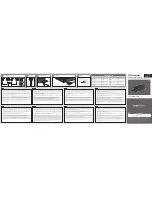
17
Housing Conversion Circuitry
This housing has Conversion Circuitry built into the housing. When used
with Ikelite DS Substrobes the Conversion Circuitry provides real Nikon
iTTL flash exposure with over and under-exposure compensation from
+1 1/3 to - 1 1/3 f-stops in 1/3 stop increments.
The Conversion Circuitry also offers Manual exposure control with 3 1/2
f-stops of under-exposure control in 1/2 stop increments.
The Conversion Circuitry is powered by the Ikelite DS Substrobe when
connected to the housing with the #4103.51 single or #4103.52 dual
sync cord. When using two strobes with the dual sync cord, the primary
strobe connected to the cord without the red band, must be turned on to
power the Conversion Circuitry. Always keep both strobes connected to
your dual sync cord underwater. Do not exchange your secondary
strobe for a dust cap which may not be waterproof.
See page 18 for DS50 and DS125 Substrobe compatibility with the
Conversion Circuitry.
Using the Conversion Circuitry
(Set DS Substrobe to TTL mode)
-
Mode and Compensation Dial
(see illustration on Page 18)
Note that the TTL compensation values are located in the yellow band.
Manual compensation values are located in the black band. Rotate the
Dial to switch between TTL and Manual Modes.
-
TTL Mode
compensation values are indicated in the yellow band. Place
the Setting Indicator to
TTL for NO Compensation
. Rotate the Dial either
direction to /- compensation. Place the Setting Indicator to the
desired compensation value. Note that in TTL, compensation values are
in 1/3 f-stops.
-
Manual Mode
compensation values are indicated in the black band.
Rotate the Dial to place the Setting Indicator to the desired compensation
value. Note that in Manual Mode, compensation values are in 1/2 f-stops
from (F) full power to -3 f-stops.
Set DS Substrobe to TTL mode. This will allow the strobe power to
be varied in manual mode.












































